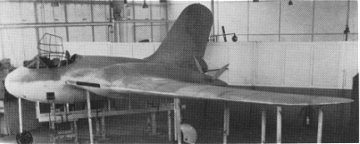 Following the failure of the Me 210 heavy fighter aircraft (which was upgraded
to the Me 410 by lengthening the fuselage and adding more powerful engines),
a search was begun on a new design for a twin-engine heavy fighter. Professor
Alexander Lippisch began work on his Li
P.10, and at the same time Dr. Hermann Wurster independently developed
the 329. After both submitted their ideas, Willy Messerschmitt asked to
have a performance comparison drawn up between the Li
P.10, Me 329 and Me 410 (see table below for results).
Following the failure of the Me 210 heavy fighter aircraft (which was upgraded
to the Me 410 by lengthening the fuselage and adding more powerful engines),
a search was begun on a new design for a twin-engine heavy fighter. Professor
Alexander Lippisch began work on his Li
P.10, and at the same time Dr. Hermann Wurster independently developed
the 329. After both submitted their ideas, Willy Messerschmitt asked to
have a performance comparison drawn up between the Li
P.10, Me 329 and Me 410 (see table below for results).
The Me 329 was a tailless design, and was to be constructed mainly of wood. This would save on strategic materials and keep the weight lower. As many components of the Me 410 were to be used as possible to save time on factory retooling. The large area wing was swept back at approximately 26 degrees, and two Daimler-Benz DB 603 or Jumo 213 piston engines were buried in the wings, each driving a 3.4 meter (11.2 feet) pusher propeller. A single large fin and rudder was mounted at the rear. The main landing gear retracted forwards, and the twin-wheeled front gear retracted to the rear. A two-man crew sat under an extensively glazed cockpit, with the pilot and navigator/rear gunner sitting in a staggered side-by-side arrangement. Armament consisted of four MG 151/20 20mm cannon mounted in the nose, and two MK 103 30mm cannon in the wing roots. A single MG 151/20 20mm cannon was located in a remote controlled barbette in the tail, which was aimed via a periscope system from the cockpit. Up to 2400 kg (5291 lbs) of bombs could be carried in an internal bomb bay or underwing racks.
Some of the roles envisioned for the Me 329 were:





